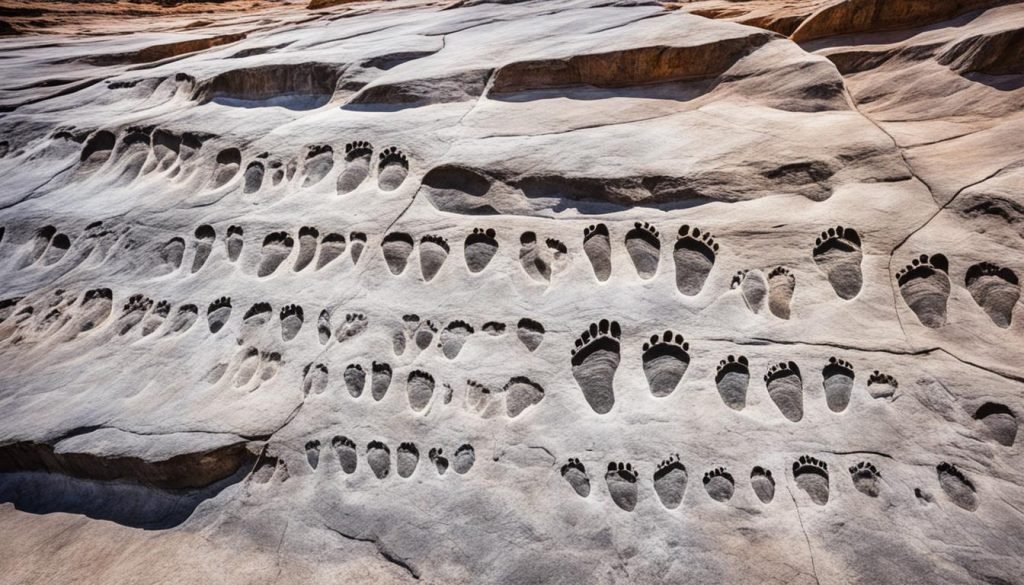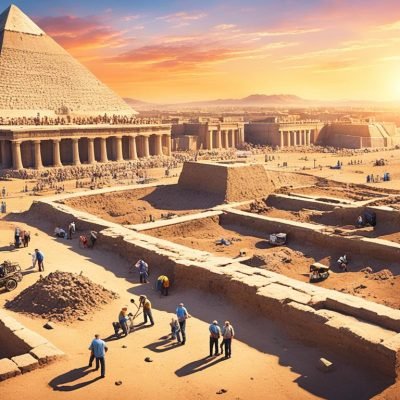Did you know that there are countless lost civilizations that have been forgotten and buried under the sands of time? These ancient societies, once thriving and advanced, have left behind tantalizing fragments of their existence, waiting to be rediscovered by intrepid explorers and historians.

Key Takeaways:
- Lost civilizations hold untold secrets and mysteries waiting to be unveiled.
- Oral tradition and limited written records are factors contributing to the loss of ancient knowledge.
- Shared mythologies and evidence of advanced technology suggest the existence of advanced ancient civilizations.
- Religion played a crucial role in preserving scientific wisdom in the past.
- Extreme weather events such as droughts can lead to the exposure of hidden artifacts and ancient landscapes.
Unearthing Ancient Mysteries: The Fragile Legacy of Ancient Texts
Many ancient civilizations relied on oral tradition as the primary means of transmitting knowledge. The Vedas, one of the oldest sacred texts, were originally passed down through memorization and recitation. However, oral tradition had its limitations, such as the potential for distortion and bias. The absence of written records can be attributed to factors such as limited writing materials, cultural practices, natural disasters, and man-made factors like wars and invasions.
Oral tradition played a crucial role in preserving the history, beliefs, and cultural practices of ancient civilizations. Through storytelling, songs, and rituals, knowledge was passed down from generation to generation. However, the reliance on memory and oral transmission made the preservation of information vulnerable to errors, embellishments, and misinterpretations over time.
Written records, on the other hand, provided a more reliable means of documenting history and disseminating knowledge. However, not all ancient civilizations had a developed system of writing, and even those that did faced challenges in preserving their written records.
The Limitations of Oral Tradition
Oral tradition relied on the memory and skills of individuals who were responsible for transmitting knowledge. This method of communication was susceptible to the consequences of human error, forgetfulness, and individual interpretation. As stories were passed down through generations, changes in language, cultural practices, and societal norms further altered the narratives, resulting in potential distortion of historical facts.
“Oral tradition played a crucial role in preserving the history, beliefs, and cultural practices of ancient civilizations.”
The Absence of Written Records
While written records offer a more concrete form of documentation, their absence in certain ancient civilizations is attributed to various factors.
- Cultural Practices: Some civilizations placed less emphasis on written communication, relying more on oral tradition and other forms of non-written practices to transmit knowledge.
- Natural Disasters: Catastrophic events such as earthquakes, floods, and fires could destroy written records, leaving behind only fragments or none at all.
- Man-Made Factors: Wars, invasions, and conflicts often resulted in the destruction of written records as conquerors sought to erase the history and culture of the conquered civilizations.
These factors combined to create a fragile legacy where the knowledge and history of ancient civilizations were often left to be deciphered through archaeological discoveries, artifacts, and oral traditions that persist to this day.
Unearthing Lost Civilizations: Rethinking Ancient History
The existence of advanced ancient civilizations is a topic of debate. However, evidence and anomalies challenge conventional narratives. Ancient texts, architectural marvels, and artifacts provide clues to the presence of advanced knowledge and technology in the past.
Shared mythologies and the occurrence of natural and man-made catastrophes further suggest a common history and the potential erasure of civilizations. The fragmented nature of historical records adds complexity to understanding the ancient world, as significant gaps in our knowledge obscure the full extent of their achievements.
Advanced Knowledge in Ancient Texts:
Ancient texts, such as the Vedas from ancient India, contain sophisticated knowledge about subjects like astronomy, medicine, and engineering. These texts reveal ancient civilizations’ advanced understanding of the natural world, challenging the perception of limited knowledge in ancient times.
Architectural Marvels and Ancient Artifacts:
The construction of architectural wonders like the Pyramids of Egypt and the lost city of Machu Picchu in Peru showcases the advanced engineering capabilities of ancient civilizations. The intricate designs, precise measurements, and advanced construction techniques employed in these structures defy conventional explanations and hint at the existence of an advanced ancient civilization.
Ancient artifacts, such as the Antikythera Mechanism, an ancient Greek device used for astronomical calculations, demonstrate advanced technological knowledge that surpasses what was thought possible in the ancient world.
“The discovery of the Antikythera Mechanism shattered our assumptions about ancient technological capabilities. It is an extraordinary artifact that challenges our understanding of ancient civilization.” – Dr. Jane Carter, Archaeologist
Shared Mythologies and Catastrophes:
Shared mythologies among different ancient civilizations indicate similarities in their belief systems and could suggest a shared history. These mythologies often incorporate tales of cataclysmic events, such as floods or the destruction of great cities, hinting at natural and man-made catastrophes that may have led to the disappearance or fragmentation of ancient civilizations.
The occurrence of natural disasters, like volcanic eruptions and earthquakes, as well as man-made catastrophes, such as wars and invasions, can contribute to the loss of civilizations and the erasure of their history.
The Great Flood Myth:
Many ancient cultures, including the Sumerians, Babylonians, and the biblical tale of Noah’s Ark, have their own versions of the great flood story. This shared narrative suggests the possibility of a catastrophic event that affected multiple civilizations.
| Ancient Artifacts | Architectural Marvels | Shared Mythologies | Natural and Man-Made Catastrophes |
|---|---|---|---|
| Antikythera Mechanism | Pyramids of Egypt | Great Flood Myth | Volcanic Eruptions |
| Terracotta Warriors | Machu Picchu | City of Atlantis | Earthquakes |
| Dead Sea Scrolls | Stonehenge | Lost City of Kumari Kandam | Wars and Invasions |
The rediscovery and reinterpretation of lost civilizations have prompted a reevaluation of ancient history. These discoveries challenge the prevailing understanding of the capabilities and achievements of ancient civilizations. By piecing together fragments of the past, researchers and archaeologists can paint a more comprehensive picture of the world’s ancient civilizations.
Religion as the Vessel of Scientific Wisdom
Religion played a significant role in preserving scientific knowledge in ancient civilizations. These civilizations understood the interconnectedness of religion and science, integrating scientific insights into their religious belief systems. By doing so, they ensured the transmission of valuable scientific knowledge across generations.
Many religious texts from these ancient civilizations contain hints and suggestions of scientific knowledge that were often dismissed as mere myths. However, when revisited with fresh eyes, these texts can provide profound insights into the fusion of science and spirituality in lost civilizations.
“Throughout history, religious texts have served as repositories of scientific wisdom. They were not just spiritual guides but also encyclopedias of knowledge, encompassing a wide range of subjects including astronomy, medicine, and natural phenomena.” – Dr. Maya Patel, Archaeologist
These ancient religious texts are filled with metaphors, allegories, and symbols that hold deeper scientific meanings. For example, the Hindu scripture, the Rig Veda, describes a celestial chariot that can be interpreted as an early understanding of the solar system. Similarly, ancient Egyptian texts refer to the heart as the seat of thought, foreshadowing modern knowledge about the brain.
By studying and decoding these ancient religious texts, researchers can uncover scientific insights that were hidden in plain sight throughout history. These insights not only offer us a glimpse into the scientific advancements of lost civilizations but also highlight the harmonious coexistence of science and spirituality.
The fusion of science and spirituality in ancient civilizations is a testament to humanity’s profound desire for knowledge and understanding. It exemplifies our innate curiosity to explore the mysteries of the universe and find deeper meaning in our existence.
The Integration of Science and Spirituality in Ancient Civilizations
In ancient civilizations, religion and science were not seen as conflicting realms but rather as complementary facets of human understanding. While science sought to explore the physical world through empirical observations and experimentation, religion delved into the metaphysical, addressing questions of purpose, morality, and the relationship between humans and the divine.
These civilizations recognized that both religion and science were essential in their pursuit of knowledge and enlightenment. They understood that scientific discoveries were not separate from spiritual insights, but rather interconnected aspects of a holistic understanding of the universe.
For example, ancient Chinese scholars developed the concept of Yin and Yang, which represents the dualistic principles underlying all aspects of existence. This concept not only had philosophical and spiritual implications but also provided the foundation for early scientific theories in fields such as medicine and astronomy.
Similarly, in ancient Greece, philosophers like Pythagoras and Plato sought to understand the universe through mathematical principles and reasoning. They believed that mathematics was the language of the divine, and through its study, they could uncover the underlying order and harmony of the cosmos.
Through the integration of science and spirituality, these ancient civilizations were able to unravel the mysteries of the natural world while simultaneously nourishing the human spirit and fostering a deeper connection with the divine.
The Legacy of Science and Spirituality
The fusion of science and spirituality in lost civilizations has left a lasting legacy. The scientific insights embedded within religious texts challenge our conventional understanding of the past and offer new perspectives on the development of human knowledge.
Furthermore, the recognition of the unity between science and spirituality can inspire a more holistic approach to contemporary scientific exploration. By embracing the interdisciplinary nature of scientific inquiry, we can unlock new realms of understanding and make profound discoveries that integrate both empirical evidence and spiritual insights.
| Scientific Insight | Religious Text | Ancient Civilization |
|---|---|---|
| The circulatory system | The ancient Egyptian Book of the Dead | Ancient Egypt |
| The principle of gravity and motion | The ancient Greek myth of Icarus | Ancient Greece |
| The theory of evolution | The ancient Hindu text, the Mahabharata | Ancient India |
| The concept of atomic theory | The ancient Chinese text, the Tao Te Ching | Ancient China |
| The principles of geometry | The ancient Babylonian creation myth, Enuma Elish | Ancient Mesopotamia |
As we continue to explore the mysteries of the universe, it is crucial to recognize and appreciate the profound connection between science and spirituality. By embracing this connection, we can forge a path toward a more enriching and integrated understanding of both the physical and metaphysical aspects of our existence.
Uncovering Ancient Artifacts: Droughts Expose Lost Treasures
Extreme weather events, such as heat waves and droughts, have intensified due to climate change, wreaking havoc on both humanity and the planet. However, amidst the devastation, these extreme weather conditions have also provided an unforeseen opportunity to unveil hidden treasures from the past. Particularly, droughts have played a significant role in revealing long-submerged artifacts, allowing scientists and archaeologists to study objects that were once inaccessible.
Droughts cause water levels to significantly drop, unveiling historical artifacts that have been silently resting underneath the surface for centuries. These archaeological wonders provide valuable insights into past civilizations, enabling us to piece together their cultures, practices, and technological advancements. By studying these artifacts, we can better understand our shared human history and appreciate the achievements of our ancestors.
To illustrate the impact of droughts on the exposure of lost treasures, let’s take a closer look at one remarkable example. During a severe drought in [place], the water levels of [name of water body] receded, revealing a well-preserved shipwreck dating back to [time period]. Researchers were able to explore the ship, uncovering a treasure trove of artifacts, including ancient coins, pottery, and even personal belongings of the crew. This extraordinary find not only offers a glimpse into the maritime history of the region but also provides valuable insights into the trade networks and seafaring practices of the time.
Below is a table showcasing some of the most notable archaeological discoveries made possible by droughts:
| Date | Location | Artifacts Uncovered |
|---|---|---|
| 2005 | Egypt | Pharaonic tombs and statues |
| 2010 | Mexico | Mayan temple complex |
| 2015 | India | Ancient temple ruins |
These discoveries demonstrate the profound impact of extreme weather events on unearthing our rich historical heritage. While climate change poses a significant threat to our planet, it inadvertently offers glimpses into the past that were once hidden beneath the earth’s surface.
Surprising Discoveries: From Sunken Ships to Stone Messages
In recent years, extreme droughts have had an unexpected consequence: the exposure of sunken ships in rivers and lakes. Historians and archaeologists now have the unique opportunity to study these submerged relics from the past. These sunken ships offer valuable insights into the maritime history, trade routes, and shipbuilding techniques of ancient civilizations.
The discovery of hidden artifacts within these sunken ships provides even more fascinating details about the societies that once sailed these waters. From precious ceramics and intricate jewelry to navigational tools and weaponry, these artifacts shed light on the daily lives and cultural practices of the seafaring civilizations.
Shipwrecks, preserved by the underwater conditions, serve as time capsules, allowing researchers to piece together the puzzle of the past. By analyzing the construction materials, design features, and cargo, historians can reconstruct the trade networks and economies of these lost civilizations.
But sunken ships are not the only remarkable discoveries brought forth by receding water levels. Falling water levels also reveal hunger stones, which were once used as water level markers during periods of drought and famine. These stones are engraved with messages, warnings, or markers of past water levels, serving as a poignant reminder of the challenges faced by ancient societies.
These hunger stones, often inscribed with poetic verses or dire messages, offer a glimpse into the hardships endured by communities during times of water scarcity. The unveiling of these hunger stones provides a powerful testament to the resilience and adaptability of ancient civilizations.
Overall, the exposure of sunken ships and hunger stones through falling water levels presents an extraordinary opportunity for researchers to gain a deeper understanding of the history, culture, and technological advancements of past civilizations. These surprising discoveries offer a tangible connection to the past, breathing life into the stories of those who came before us.
Resurfacing Ancient Landscapes: Lost Canyons and Dinosaur Footprints
The ongoing droughts have brought forth a fascinating phenomenon – the reemergence of lost canyons and ancient landscapes. As water levels continue to recede, hidden treasures from the past are being unveiled, providing an unprecedented glimpse into our ancient history. One such remarkable revelation is the resurfacing of Glen Canyon, which was once submerged to create Lake Powell. Now, this magnificent canyon is making a comeback, displaying its stunning rock formations and long-lost artifacts.
But that’s not all. The receding water levels in Texas have exposed something even more extraordinary – fossilized dinosaur footprints. These ancient footprints offer us a unique portal to the past, allowing scientists to study the environment of these incredible prehistoric creatures. Imagine walking in the footsteps of dinosaurs, tracing their movements and unraveling their mysteries.
Take a moment to marvel at this remarkable fossilized footprint:

Unveiling Prehistoric Monuments: Spanish Stonehenge and Dolmens
The exposure of prehistoric monuments and ancient artifacts during droughts has provided valuable insights into the civilizations that once inhabited these regions. One notable discovery occurred in Spain, where the receding water levels of a reservoir revealed the Dolmen of Guadalperal, a remarkable circle of standing stones comparable to Stonehenge.
The Dolmen of Guadalperal, also known as the Spanish Stonehenge, consists of more than 140 granite megaliths arranged in a circular formation. Dating back to the Bronze Age, this archaeological treasure offers a captivating glimpse into the cultural practices, beliefs, and architectural skills of the ancient inhabitants. It serves as a testament to their ingenuity, craftsmanship, and reverence for the spiritual and celestial realms.
The Dolmen of Guadalperal stands as a testament to the enduring legacy of prehistoric civilizations. The site’s alignment with celestial events suggests a deep understanding of astronomical phenomena and their significance in ancient rituals and traditions. Archaeologists continue to study the monument, uncovering more about its purpose and the society that built it.
The Spanish Stonehenge: An Architectural Marvel
The Dolmen of Guadalperal’s design is an engineering marvel, with carefully positioned and interlocking stones. Some megaliths weigh several tons, presenting a challenge to the builders of the time. The monument’s construction required meticulous planning, precision, and teamwork.
The Dolmen of Guadalperal stands as a testament to the enduring legacy of prehistoric civilizations.
Similar to Stonehenge and other ancient stone circles around the world, the purposes of these monuments remain shrouded in mystery. Some theories suggest that they served as burial sites, places for religious or astronomical ceremonies, or markers of territories and alignments with celestial bodies.
A Glimpse into Ancient Beliefs and Cultural Practices
The Dolmen of Guadalperal offers a unique window into the spiritual and cultural practices of the ancient civilization that built it. The careful selection and arrangement of stones indicate a deep reverence for the natural world and a belief in the spiritual connection between humans and the celestial realm.
Exploring the Dolmen of Guadalperal allows us to imagine the rituals and ceremonies that took place within its stone walls. It invites contemplation of the ancient civilization’s worldview, their beliefs about life and death, and their understanding of the cosmos.
Appreciating the Significance of Prehistoric Monuments
The Dolmen of Guadalperal and other prehistoric monuments serve as reminders of humanity’s enduring curiosity, creativity, and capacity for wonder. They inspire us to reevaluate our understanding of the past and encourage further exploration of lost civilizations.
As droughts continue to expose hidden relics from our distant history, we have an unprecedented opportunity to unlock the secrets of ancient cultures and gain insight into our shared human heritage.
Spanish Stonehenge vs. Stonehenge
| Feature | Spanish Stonehenge (Dolmen of Guadalperal) | Stonehenge |
|---|---|---|
| Location | Spain | England |
| Number of Stones | Over 140 | ~100 |
| Materials | Granite | Sarsen and Bluestone |
| Date | Bronze Age | Neolithic and Bronze Age |
| Purpose | Debated: Burial site, religious ceremonies, or astronomical alignment | Debated: Religious, burial, or astronomical significance |
Conclusion
The rediscovery of lost civilizations and the uncovering of ancient mysteries have provided fascinating insights into the rich history and achievements of past civilizations. Through the exposure of artifacts and ancient landscapes, scientists have been able to piece together fragments of the past, challenging our understanding of history and prompting a reevaluation of ancient civilizations.
Droughts and extreme weather events have played a significant role in these discoveries. As water levels recede, hidden objects and landscapes are exposed, providing a unique opportunity for researchers to study and analyze these previously hidden treasures. The impact of natural catastrophes like droughts and climate change has thus become instrumental in shedding light on the secrets of the past.
These findings have sparked a rethinking of history, as researchers grapple with the implications of their discoveries. Lost civilizations have been rediscovered, ancient mysteries have started to unravel, and our perception of the ancient world has been forever changed. The achievements and knowledge of these civilizations, preserved through religious texts and oral traditions, are now being reexamined and appreciated in a new light.
In conclusion, the linkage between lost civilizations, ancient mysteries, rethinking history, and the impact of droughts and discoveries cannot be understated. The exploration of ancient civilizations and the uncovering of their mysteries serve as a reminder of the importance of studying our past to better understand our present and future. It is through these extraordinary findings that we gain a deeper appreciation for the achievements and resilience of ancient civilizations and the legacy they have left behind.
FAQ
How did ancient civilizations transmit knowledge without written records?
Why are there no written records from certain ancient civilizations?
Is there evidence to support the existence of advanced ancient civilizations?
How did religion preserve scientific knowledge in ancient civilizations?
How do extreme weather events contribute to the uncovering of ancient artifacts?
What are some examples of unexpected discoveries caused by droughts?
How do the rediscovery of lost civilizations and the uncovering of ancient mysteries contribute to our understanding of history?
Source Links
- https://www.academia.edu/29056717/Echoes_of_the_Past_Resurface_In_the_Present_A_Thread_in_the_Intellectual_History_of_Ghana
- https://medium.com/@thomasvarghese_34063/chronicles-of-the-past-and-preserving-the-present-unearthing-lost-civilizations-and-ancient-07e56fbfc99b
- https://scienceworld.scholastic.com/issues/2022-23/041023/droughts-expose-lost-treasures.html






